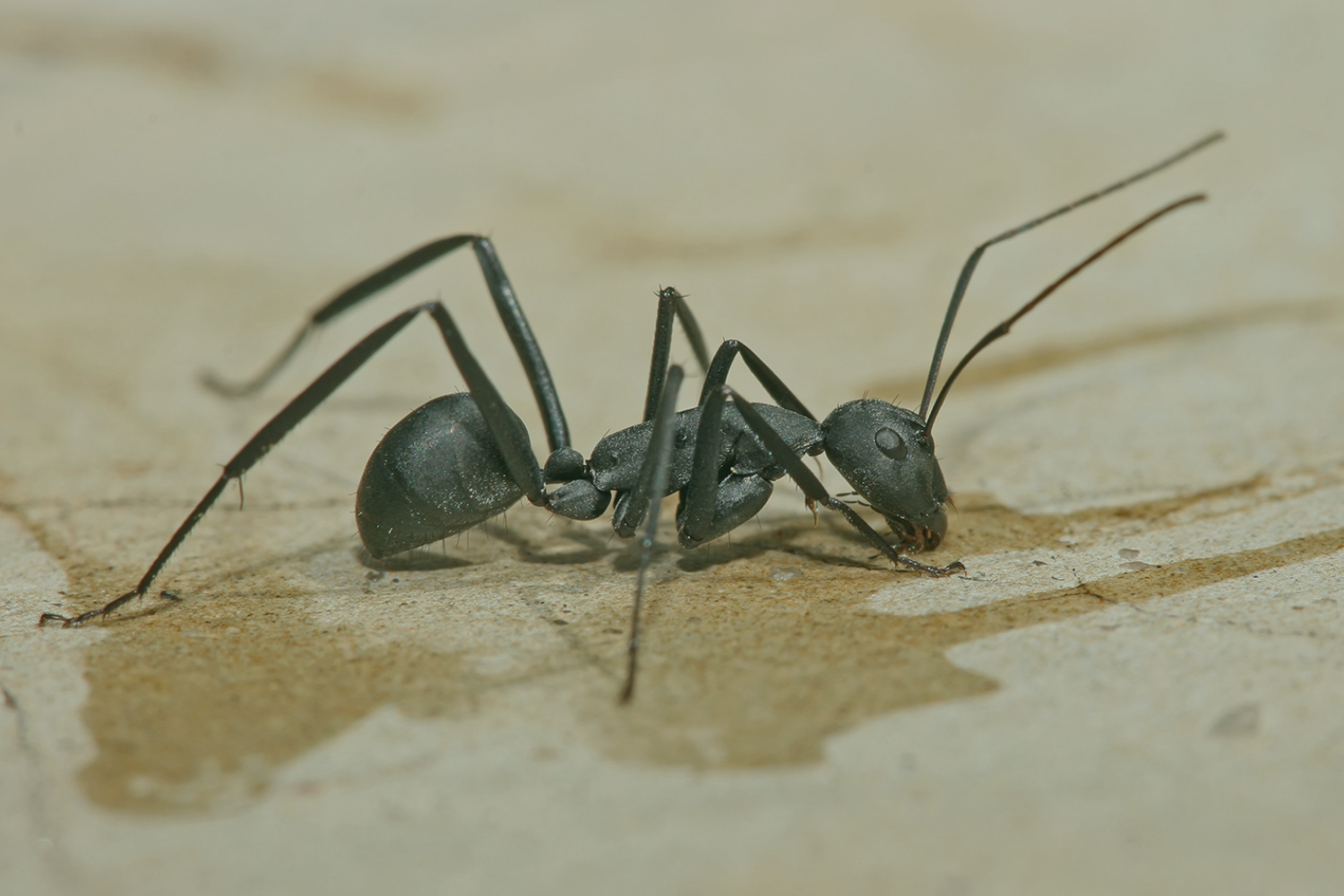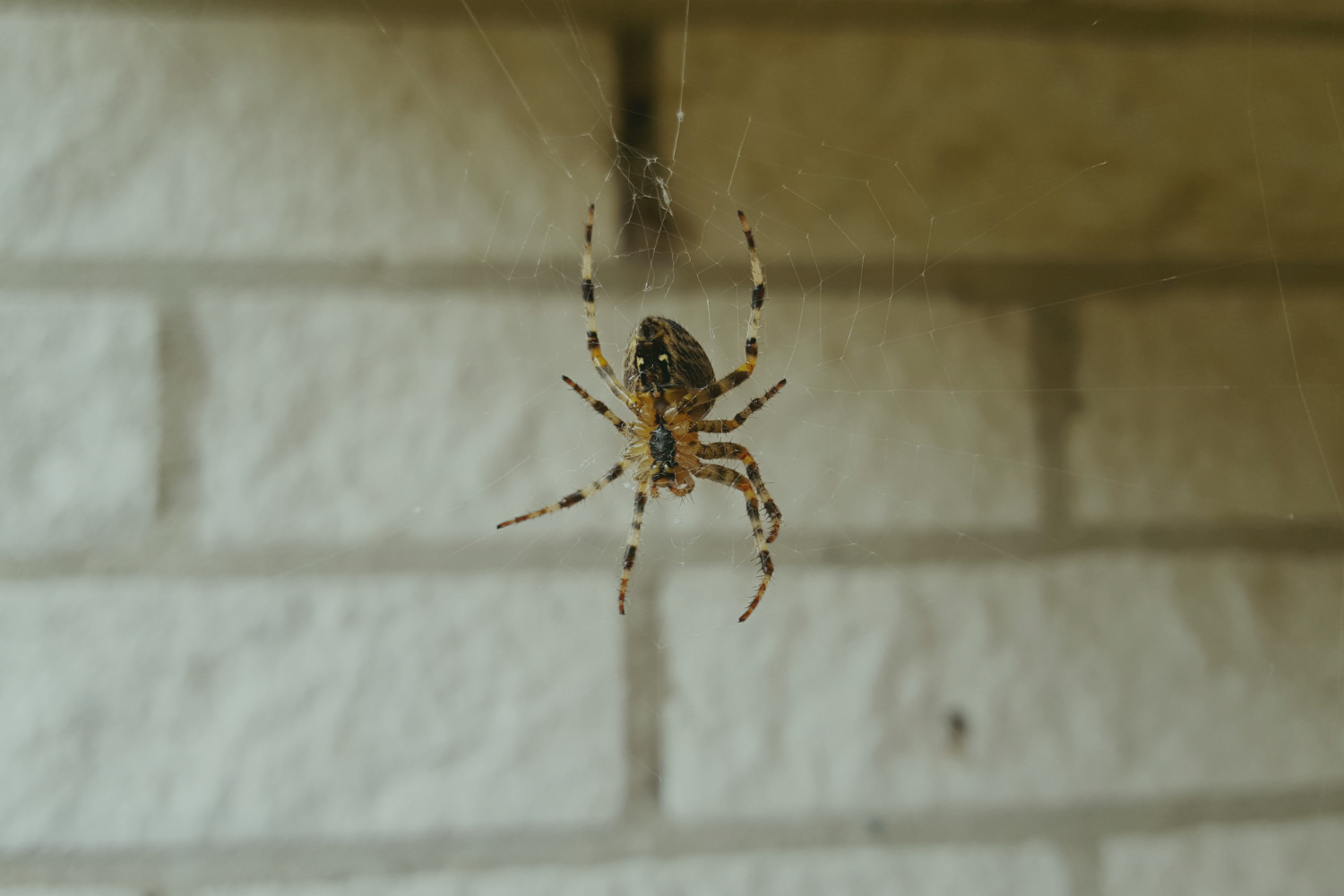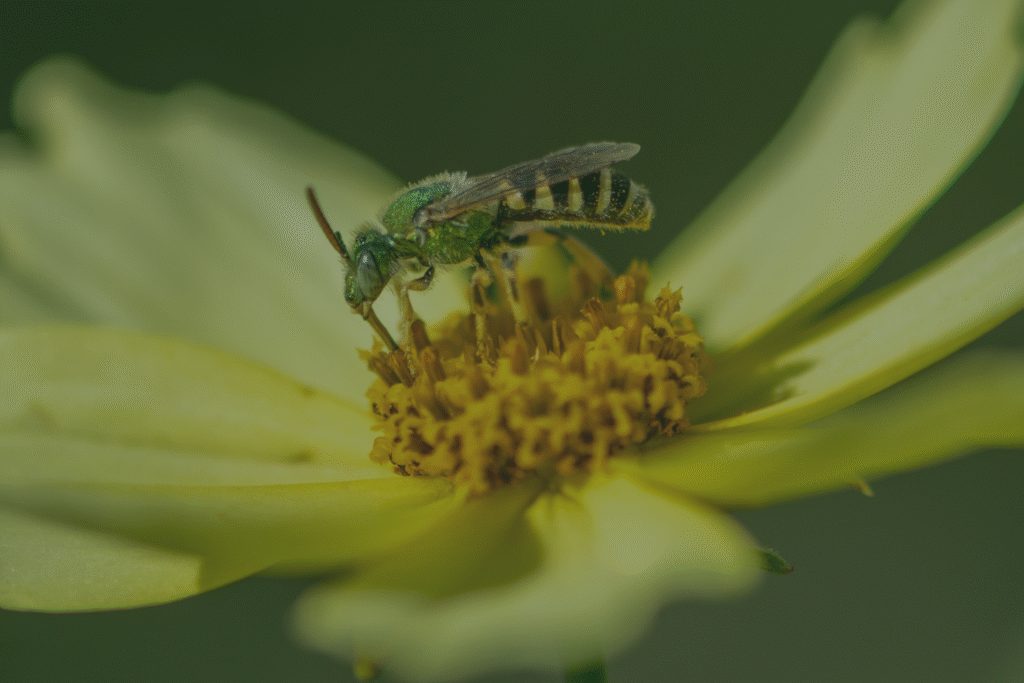
If you’ve noticed small bees landing on your skin while you’re outdoors, you may wonder: do sweat bees bite or sting? The quick answer is that sweat bees don’t bite. However, they can sting if they feel threatened or trapped.
This post will help you understand what sweat bees are, why they’re so interested in people, and how to keep them from becoming a nuisance around your home.
What Are Sweat Bees?
Sweat bees are members of the Halictidae family, one of the largest groups of bees in the world. There are more than 1,000 species in North America alone, and they range in appearance from dark brown to shiny metallic green or blue.
Despite their small size (often less than half an inch), sweat bees are some of the most important pollinators for flowers, fruits, and vegetables.
They get their name because they are attracted to the salt found in human sweat. Unlike honeybees or bumblebees, sweat bees are solitary foragers. Many species nest in the ground, especially in bare soil, lawns, or garden beds.
This means homeowners are most likely to encounter them while gardening, mowing, or enjoying outdoor spaces.
While sweat bees provide real benefits to the environment, their behavior around people often puts them in the “pest” category. Nobody wants bees constantly landing on them during a barbecue or while doing yard work.
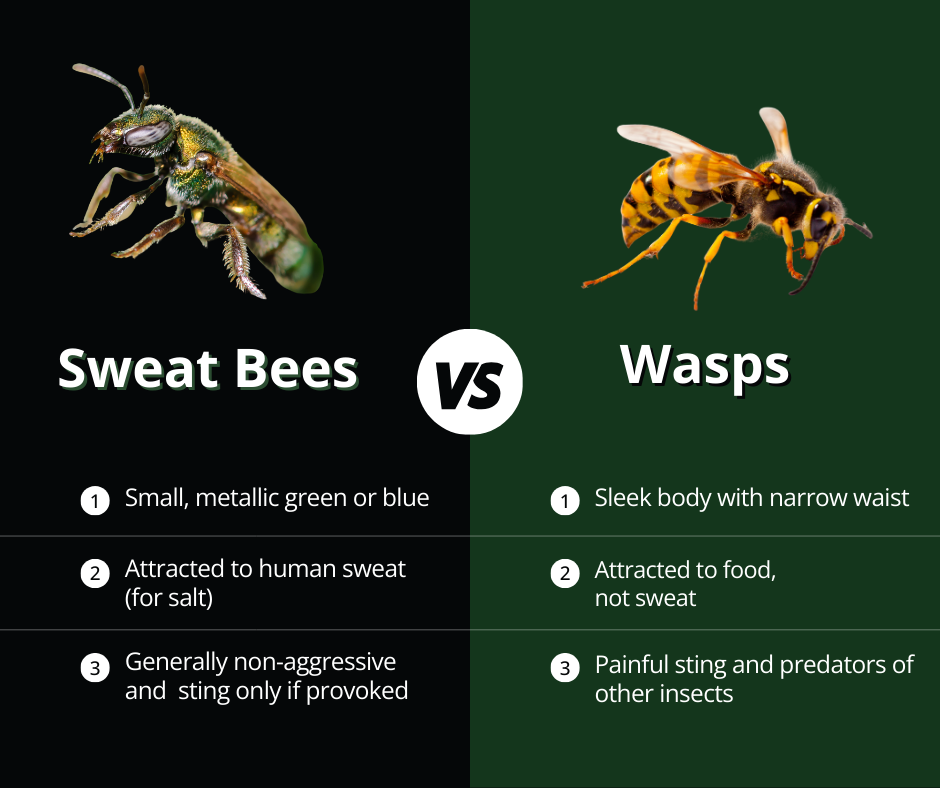
Do Sweat Bees Bite or Sting
Sweat bees do not bite people. Instead, they may sting if they feel pressed against your skin, swatted at, or trapped in clothing.
Here’s the good news: sweat bee stings are generally mild.
They cause less pain than stings from wasps, hornets, or even honeybees. Unlike aggressive insects that attack unprovoked, sweat bees are more likely to be curious than hostile. In most cases, they land on your skin only to collect salt from sweat.
Still, stings happen. For homeowners with kids, pets, or outdoor living spaces, the presence of sweat bees buzzing around can make time outside less enjoyable.
Are Sweat Bee Stings Dangerous
For most people, a sweat bee sting feels like a quick prick, followed by mild irritation. You might notice:
- A sharp sting at the site
- Redness and slight swelling
- A small itchy bump that fades within a few hours
Unlike wasps or yellow jackets, sweat bees are not known for repeated stings or aggressive swarming. That said, allergic reactions are always possible. Symptoms such as difficulty breathing, nausea, or swelling in the face require immediate medical attention.
Because sweat bees are small and not aggressive, their stings rarely require treatment beyond washing the area and applying a cold compress. Over-the-counter antihistamines can help with itching if needed.
Many homeowners mistake sweat bees for more aggressive pests. If you’re unsure whether you’re dealing with sweat bees or something more dangerous, like ground-nesting yellow jackets, it’s a smart idea to reach out to a pest control professional for identification.
Why Are Sweat Bees Attracted to You
Sweat bees are unusual because they are actively attracted to people.
Unlike other stinging insects that buzz around food or trash, sweat bees are drawn to the salt and moisture in human sweat. That’s why you may notice them landing directly on your arms, neck, or face when you’re outside in warm weather.
Other factors that make sweat bees more active include:
- Bright colors: Clothing that resembles flower colors can attract them.
- Sweet scents: Perfumes, body sprays, and scented lotions can draw them in.
- Flower-rich yards: Sweat bees feed on nectar and pollen, so gardens and landscaping attract them.
- Soil conditions: Bare or sandy soil provides nesting spots for ground-dwelling sweat bees.
Because Washington summers are hot and humid, homeowners in this region are more likely to see sweat bees buzzing around during peak outdoor season.
How to Prevent Sweat Bees Around Your Home
If sweat bees are making outdoor activities uncomfortable, there are steps you can take to reduce their presence:
- Wear light-colored clothing: Dark or bright floral patterns can make you a target.
- Limit scented products: Avoid strong odors like perfumes, colognes, or floral lotions before heading outdoors.
- Tidy up flower beds and lawns: Keep grass mowed, flowers trimmed, and remove weeds to reduce nectar sources close to your house.
- Cover exposed soil: Bare patches of dirt can encourage sweat bee nesting. Mulching garden beds is a simple fix.
- Reduce excess moisture: Fix leaky outdoor faucets and avoid standing water that can make conditions more favorable for bees and other pests.
While these steps help, they don’t eliminate the problem completely. If sweat bees are repeatedly landing on you or if they’re nesting in your yard, professional pest control may be the best long-term solution.
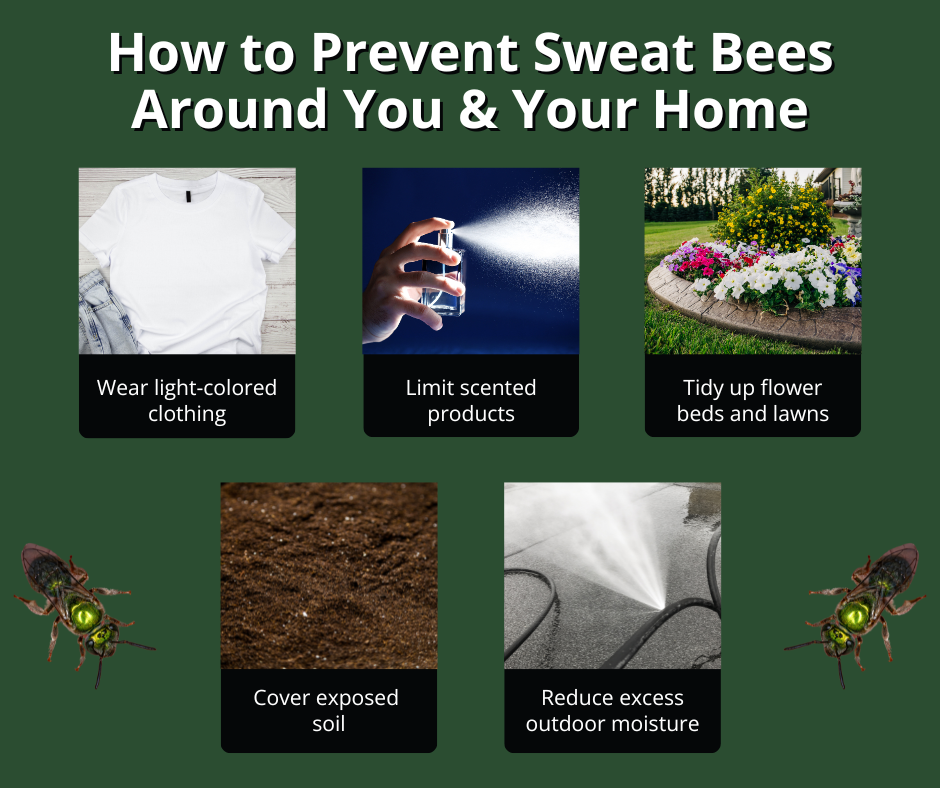
When to Call a Professional
Occasional sweat bees are part of life outdoors, but here are signs you may need help from a pest control company:
- You see multiple sweat bees buzzing around every time you step outside.
- You find small holes in soil that may indicate underground nesting sites.
- Family members or pets are stung more than once.
- You suspect the insects may actually be wasps or hornets.
Bigfoot Pest Management specializes in identifying and safely managing stinging insects in Illinois. Professionals can determine whether you’re dealing with sweat bees, wasps, yellow jackets, or hornets and use safe methods to reduce populations or remove nests. This keeps your outdoor spaces safe, comfortable, and usable throughout the summer.
Related Questions
Can sweat bees build nests in my yard?
Yes. Many species dig small burrows in bare or sandy soil. These nests may be hard to spot but can increase the number of bees in one area.
What’s the difference between sweat bees and wasps?
Sweat bees are small, often metallic in color, and less aggressive. Wasps are larger, more territorial, and deliver more painful stings.
Do sweat bees pollinate my garden plants?
Absolutely. Sweat bees are important pollinators in Washington state and play a big role in supporting flowers, fruits, and vegetables.
How do I control stinging insects near my home?
To control stinging insects, keep your yard clean, reduce nesting sites, and contact a pest control professional if the problem continues.
Conclusion
So, do sweat bees bite or sting people? Sweat bees don’t bite, but they may sting if they feel threatened. For most people, these stings are mild and don’t cause lasting problems. Still, their habit of landing on skin makes them an unwelcome guest during outdoor activities.
Simple prevention steps, like wearing light clothing and reducing nesting areas, can help. But if sweat bees or other stinging insects become a recurring problem, the safest option is to bring in professional help.
Contact Bigfoot Pest Management today for expert stinging insect control services in Olympia, Washington. Our team can identify the pest, remove nests, and help you reclaim your outdoor spaces.
What Do Carpenter Ants Look Like in Washington Homes?
When homeowners ask what do carpenter ants look like in Washington homes, the answer is simple. Carpenter ants are large black or dark red ants…
Read MoreBig House Spider? Save These Pro Identification and Control Tips
If you live in Olympia or the surrounding South Puget Sound area, you have probably seen a big house spider at least once inside your…
Read More



